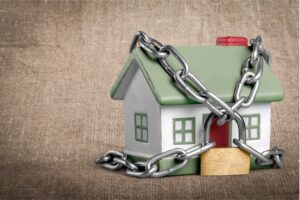 This piece originally appeared in the December 2023 edition of MortgagePoint magazine, online now.
This piece originally appeared in the December 2023 edition of MortgagePoint magazine, online now.
Homeownership has long been associated with a sense of security and stability. While this is generally still true, homeowners are starting to feel “locked” into their homes due to the interplay of their low-rate mortgages, rising interest rates, rising home prices, and the lack of inventory.
These factors are creating what is known as the real estate “lock-in effect,” but it’s not all negative. This effect also increases home equity which homeowners can access to renovate homes, save for retirement, and pay off debt.
The Lock-In Effect Defined
The term “lock-in effect” refers to a situation in which someone feels trapped or constrained by their current choices or circumstances, making it difficult to make changes or switch to alternative options.
In the case of homeownership, homeowners feel stuck in their existing properties due to unfavorable economic conditions. Today, the main driving forces behind this effect are the combination of homeowners with historically low-rate mortgages, the recent surge in interest rates, and the lack of available housing inventory to buy if they sell.
The Impact of Interest Rates
Low-interest-rate mortgages have been a boon for homeowners, allowing them to secure favorable loan terms and lower monthly payments for over a decade. However, with a rapid increase in interest rates rise—as we have seen over the last year—a problem arises. Selling their home and trading in their historically low mortgage rate pushes homeowners to stay put, even if their circumstances or preferences have changed.
In the past 20 months, the Fed has raised interest rates the quickest in history—11 times since March 2022. They paused rate hikes in June but increased them in July, going from 5%-5.25% to 5.25%-5.5%. Rates have remained steady—but still elevated—at the last two Federal Open Market Committee meetings as inflation cools. The next meeting is December 12-13, which will determine if the rates increase, decrease, or remain the same.
Consequently, the number of available homes for sale has plummeted. In October, home sale transactions were down 14.6% compared to a year ago, according to the National Association of Realtors.
Low Housing Inventory: A Compounding Factor
While interest rates are pivotal, they are not the only factor in the lock-in effect. The lack of inventory and scarcity of homes for sale has reached unprecedented levels.
Various reasons contribute to this shortage, including demographic shifts, construction labor shortages, and the lingering effects of the COVID-19 pandemic on housing supply chain constraints and material costs.
Housing starts, a measure of new home construction, dropped drastically in 2020 when the pandemic started and hasn’t caught up to accommodate the demand of a growing population.
Housing starts climbed to a seasonally adjusted annual rate of 1.372 million in October 2023, according to the U.S. Census Bureau. The number of units started was up 2% from September 2023 and 4.2% below October 2022.
Builder sentiment rose this year as demand increased but high mortgage rates since the end of August continue to dampen builder confidence as mortgage rates reach nearly 8%.
The limited availability of homes amplifies the lock-in effect, as the need for more suitable options dissuades homeowners who might have considered selling and relocating.
A Source of Anxiety
The feeling of being locked in is genuine, and some homeowners see some adverse side effects. For example, growing families need to find a larger home but can’t afford it due to current interest rates. Usually, people are trying to step up and find somewhere better to live in those scenarios, and that’s certainly difficult. The rental market feels this pressure as these starter homes are not being transitioned to first-time homebuyers, resulting in increased competition for rentals and a flight to quality.
This sense of being financially constrained within their current living situation has left many grappling with the conflicting desire for more space and the harsh reality of limited options. The prevailing economic conditions have added an unexpected layer of stress to what would otherwise be considered routine decisions, leaving families to carefully navigate the balance between their aspirations and the practical constraints of the market.
A Silver Lining: Increased Homeowner Access to Equity
One positive aspect emerges amid the complex web of factors contributing to the lock-in effect—homeowners have accumulated an incredible amount of equity. As home prices soared due to the imbalance between supply and demand over the last few years, existing homeowners see their properties appreciate.
Recent reports suggest homeowners have approximately $12 trillion in accessible home equity.
Accessing their equity provides financial security and enables homeowners to use this newfound wealth for various purposes, such as home improvements, debt payoff, or future investments. New products are available to access that home equity, including home equity investments that provide homeowners with lump sums of cash in exchange for a share of their home’s future appreciation with no monthly payments or additional debt.
So how do we stop the lock-in effect? It will require a combination of factors to change, including stabilizing interest rates, as one of the primary drivers of the lock-in effect is the fear of losing historically low-interest rates. If interest rates stabilize and decrease, homeowners may be more willing to explore moving options.
Increasing the housing supply through various means, such as incentivizing new construction or changing building permit regulations, could alleviate pressure on available housing options and give homeowners more choices.
The lock-in effect, driven by the interplay of low-rate mortgages, rising interest rates, and a scarcity of homes for sale, has become a prominent feature of today’s real estate market. Homeowners find themselves at a crossroads, torn between the desire to keep their favorable mortgage terms or the potential benefits of moving. As the housing market evolves, proactive decision-making, guided by a thorough understanding of these dynamics, will be crucial for homeowners seeking the best choices for their futures.
Future Outlook to Stop the Lock-In Effect
So, how do we stop the lock-in effect? It will require a combination of factors to change, including stabilizing interest rates, as one of the primary drivers of the lock-in effect is the fear of losing historically low-interest rates. If interest rates stabilize and decrease, homeowners may be more willing to explore moving options.
Increasing the housing supply through various means, such as incentivizing new construction or changing building permit regulations, could alleviate pressure on available housing options and give homeowners more choices.
Navigating the Lock-In Effect
The lock-in effect, driven by the interplay of low-rate mortgages, rising interest rates, and a scarcity of homes for sale, has become a prominent feature of today’s real estate market.
Homeowners find themselves at a crossroads, torn between the desire to keep their favorable mortgage terms or the potential benefits of moving.
As the housing market evolves, proactive decision-making, guided by a thorough understanding of these dynamics, will be crucial for homeowners seeking the best choices for their futures.

 theMReport.com Your trusted source for mortgage banking news
theMReport.com Your trusted source for mortgage banking news









